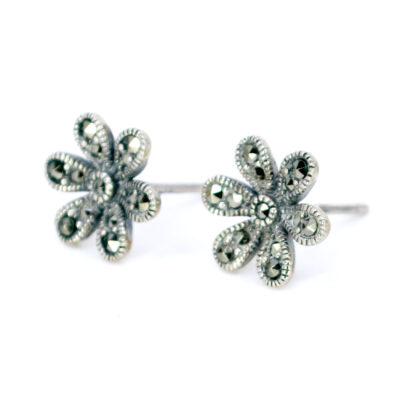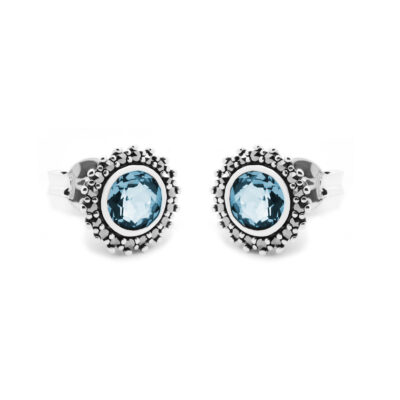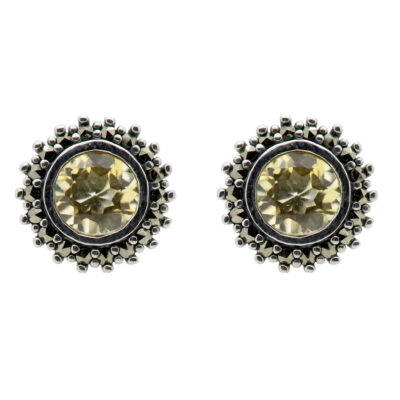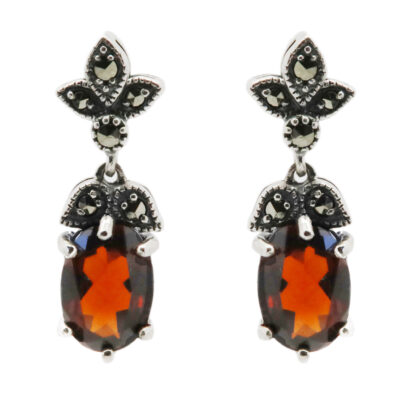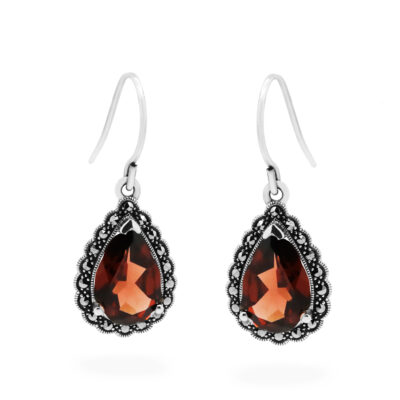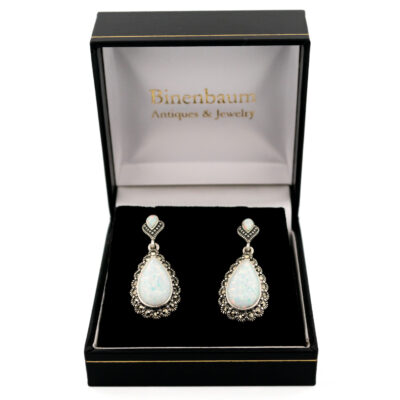These classic stud Victorian-style earrings feature round Peridots weighing approximately 0.50 carats as the centerpiece, surrounded by a halo of Marcasites (Pyrite) and set in silver.
Details: ±1.00ct Peridots, Marcasites (pyrite), Silver Earrings.
Design Era: New Victorian.
Weight in grams: 2.
Condition: New.
Shipping and Pickup: This classic piece ships from our store located in the center of Amsterdam, The Netherlands. We offer both registered shipping and local pickup at our store. In the case of local pickup, any applicable shipping costs will be refunded.
About Us: Add some sparkle to your style with Binenbaum.com. We offer a stunning selection of antique and vintage jewelry that you won’t find anywhere else. From timeless rings and dazzling necklaces to unique brooches, we have something for every taste and occasion. Visit our website today and treat yourself to a piece of history.
| Design Era | |
|---|---|
| Design & Historical Context | The Victorian Era spanned Queen Victoria's rule of England from 1837 until 1901. During this time, a middle class began to emerge, sparking a demand for jewelry in the mass market, jewelry trends often reflected the tone of current events. The era is usually divided into several subsections: the Romantic Period from 1837 to 1861, the Grand Period from 1861 to 1880, and the Aesthetic Period from 1880 to 1901. During the Romantic Period jewelry also featured nature-inspired designs, similar to jewelry of the Georgian era. Frequently, these designs were delicately and intricately etched into gold. Lockets and brooches were popular in daytime jewelry during the early Victorian era, whereas colored gemstones and diamonds were worn during the evening. During the Grand Period jewelry , because the Grand or Mid-Victorian era corresponded with the death of Queen Victoria's husband, many jewelry pieces have solemn, somber designs. Known as mourning jewelry, the pieces feature heavy, dark stones. Jet, onyx, amethyst, and garnet are frequently found in jewelry from this period. Compared to previous periods, Mid-Victorian-era jewelry features highly creative, colorful designs using shells, mosaics and gemstones. During the Aesthetic period, jewelers used diamonds and feminine, bright gemstones such as sapphire, peridot, and spinel. Star and crescent designs as well as elaborate hat pins were also popular. Some scholars believe the aesthetic era began sooner, in 1875, and ended as early as 1890. |
| Key Materials | |
| Materials & Craftsmanship | Peridot: The Gem of Light and Renewal Peridot, with its vibrant green hue, is a gemstone that symbolizes light, renewal, and growth. This stunning gem is one of the few gemstones that occur in only one color, ranging from a yellowish-green to a deep olive, depending on the amount of iron within the crystal structure. Peridot is a type of olivine and is formed deep within the Earth’s mantle, often brought to the surface by volcanic activity. Historically, peridot has been revered for its protective qualities. The ancient Egyptians called it the gem of the sun, believing it could ward off evil spirits and bring the wearer happiness and peace. Peridot was also highly valued in ancient Rome, where it was worn as a talisman for protection and was thought to bring good fortune. In modern jewelry, peridot is celebrated for its fresh, lively color and its ability to brighten any design. With a Mohs hardness of 6.5 to 7, peridot is durable enough for everyday wear, making it a popular choice for rings, necklaces, and earrings. Its bright green color pairs beautifully with gold and silver, adding a touch of warmth and vibrancy to any piece. Peridot is more than just a gemstone; it is a symbol of positivity, renewal, and the enduring beauty of nature. Its radiant green hue and rich historical significance make it a joyful and elegant choice for jewelry that inspires and uplifts. Marcasite (pyrite): The Gem of Timeless Elegance and Vintage Charm Marcasite, often mistakenly referred to as pyrite, is a gemstone that has captivated jewelry enthusiasts for centuries with its metallic luster and vintage appeal. Although marcasite is technically a form of pyrite, true marcasite jewelry is made from pyrite crystals that are cut and polished to create a shimmering, antique look. Historically, marcasite has been admired for its mysterious, reflective surface, often used in intricate, filigree designs during the Victorian and Art Deco periods. In the 18th and 19th centuries, it became particularly popular in Europe as a more affordable alternative to diamonds, lending an air of elegance and sophistication to brooches, rings, and other accessories. In modern jewelry, marcasite is prized for its ability to add a touch of vintage charm and drama to any piece. Its metallic, gunmetal-gray hue pairs beautifully with silver settings, and its natural sparkle makes it a standout in both understated and ornate designs. Marcasite is commonly seen in rings, earrings, pendants, and brooches, often set in sterling silver to enhance its classic, antique look. Marcasite is more than just a gemstone; it is a symbol of timeless elegance and enduring style. Its historical significance and unique, reflective quality make it a cherished choice for jewelry that exudes both character and sophistication, perfect for those who appreciate the charm of vintage-inspired designs. Silver: The Metal of Elegance and Versatility Silver, known for its bright, reflective luster, is one of the most beloved and widely used precious metals in the world. This versatile metal has been cherished for thousands of years, not only for its beauty but also for its malleability, making it ideal for crafting intricate and delicate jewelry designs. Historically, silver has been associated with the moon and considered a symbol of purity, clarity, and protection. Ancient civilizations, from the Egyptians to the Greeks and Romans, valued silver for its beauty and used it to create coins, jewelry, and religious artifacts. In many cultures, silver is also believed to have healing properties, often used in amulets and talismans to ward off negative energy. In modern jewelry, silver is prized for its affordability, versatility, and timeless appeal. Sterling silver, an alloy of 92.5% pure silver and 7.5% other metals (usually copper), is the standard used in high-quality jewelry. Its durability and bright, reflective surface make it an excellent choice for a wide range of designs, from minimalist pieces to ornate creations. Silver can be polished to a high shine or given a matte, oxidized, or antiqued finish to suit various styles. Silver is more than just a metal; it is a symbol of elegance, flexibility, and understated luxury. Its enduring popularity and wide-ranging applications make it a staple in jewelry that can complement any look, from casual to formal, with timeless grace. |
| Gender | |
| Weight (in grams) | 2 |
| Condition |
By following these tips, you can enjoy your precious jewelry for many years to come.
Related Products
-
Marcasite (Pyrite) Silver Stud Earrings 12097-7345
€ 65,00 VAT incl. (where applicable) -
Marcasite (Pyrite) Topaz Silver Stud Earrings 17148-2869
€ 125,00 VAT incl. (where applicable) -
Citrine Marcasite (Pyrite) Silver Stud Earrings 17149-2870
€ 125,00 VAT incl. (where applicable) -
Marcasite (Pyrite) Silver Stud Earrings 14778-1856
€ 75,00 VAT incl. (where applicable) -
Marcasite (Pyrite) Pearl Silver Stud Earrings 14423-1610
€ 165,00 VAT incl. (where applicable) -
Garnet Marcasite (Pyrite) Silver Pendant Earrings 17145-2866
€ 125,00 VAT incl. (where applicable) -
Garnet Marcasite (Pyrite) Silver Pendant Earrings 13942-1417
€ 145,00 VAT incl. (where applicable) -
Opal Marcasite (Pyrite) Silver Pendant Earrings 14089-1455
€ 365,00 VAT incl. (where applicable)
- Home
- Collection
- Fine Jewelry
- Silver Jewelry
- Silverware
- Boxes
- Candlesticks
- Salt and pepper shakers
- Miniatures
- Salt cellars
- Spoon Set
- Condiments
- Frames
- Napkin Ring
- Spoon
- Oddities
- Cups
- Vases
- Cutlery
- Serving Spoon And Cake Server
- Candlesticks
- Baskets
- Hanukkiah
- Spice Tower
- Yad
- Tea Set
- Sugar Castor
- Napkin Rings
- Wine Bottle Coaster
- Wine Stopper
- Tea Pot
- Jugs
- Rattles
- Hip Flask
- Miscellaneous
- Rings 💍
- About
- Contact





